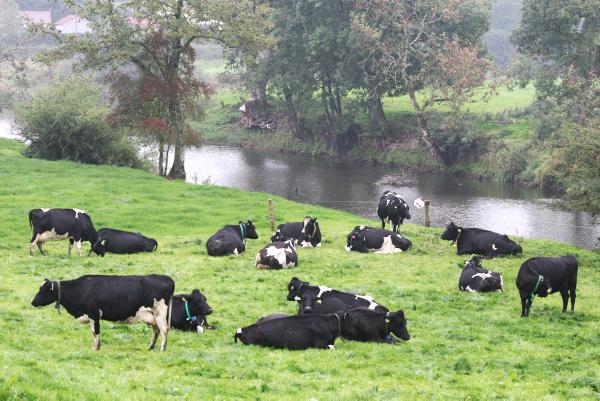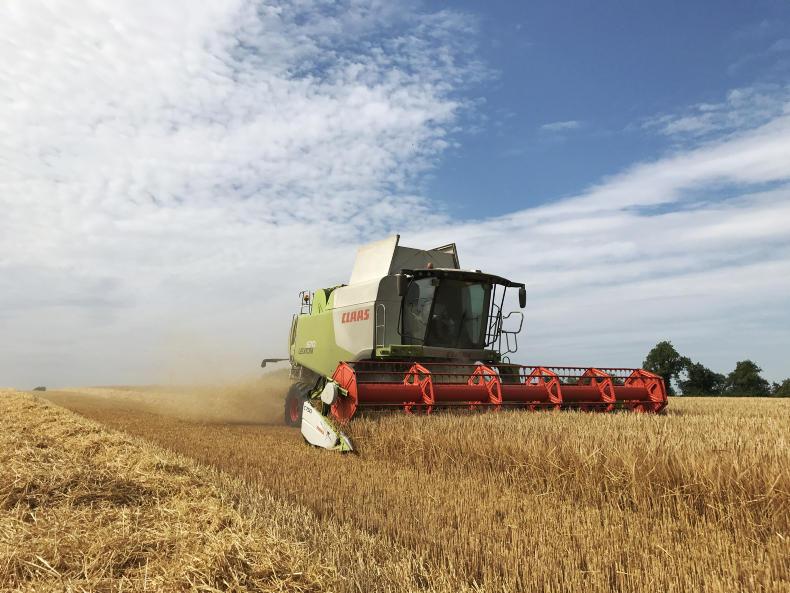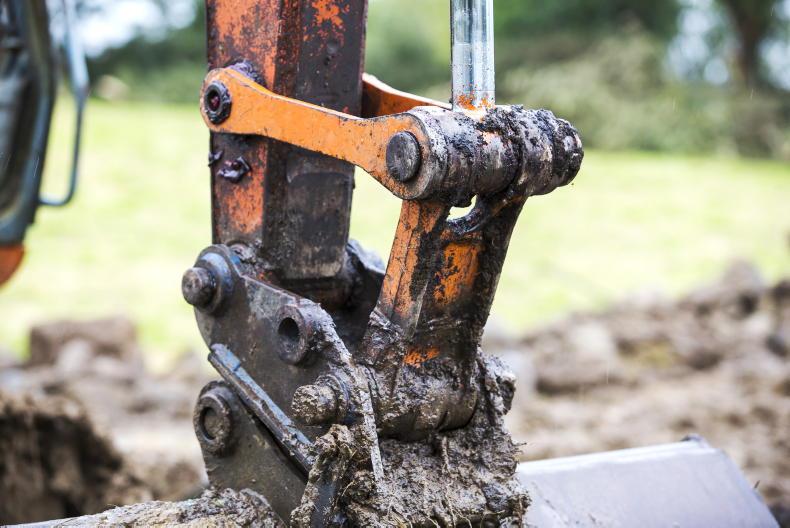On our weekly Grasswatch page, depending on where you are farming, some farmers look first to Curtin’s report and others look to the Ballyhaise report.
Curtin’s research farm in Fermoy has flat, free-draining land and grew 13tDM/ha this year despite mini droughts on two occasions. Over the last four years, average grass grown was close to 15tDM/ha.
Ballyhaise research farm in Cavan is situated in rolling drumlin country and floods in parts over the winter due to the River Annalee bursting its banks, but it grew 13tDM/ha this year and has a four-year average of 13.5tDM/ha.
It is clear that the dairy research farm in Ballyhaise is still capable of producing a lot of grass, which, when converted to milk, can deliver excellent profit per hectare.
The Teagasc Ballyhaise farm commenced research in 2005 and is now in its eighth year of trial work under new management. It is clear by completing reseeding, drainage and soil fertility work, this farm in Cavan can grow nearly as much grass as Curtin’s in Cork.
The growth curve in Ballyhaise is different (see Figure 1), with typically less grass grown in spring and autumn than Curtin’s but more grass grown in the summer.
This means a slightly higher silage requirement for a longer winter with the target to have 1.4 tonnes of silage DM/cow to cover a very long indoor period.
Farm manager Donal Patton also highlights how it means that grass measurement is more important to allow the decision to cut as much surplus grass as possible during periods of high growth.
Teagasc’s objective in Ballyhaise is to provide a guideline of profitable dairying for farmers on more challenging land in the Border Midlands and Western (BMW) region.
The level of performance here is currently better than what many dairy farms all over the country are achieving – despite the midlands region not being a ‘traditional’ dairy stronghold.
Development
Monaghan man Donal Patton has been charged with farm management since 2008.
The dairy section of Ballyhaise College consists of 40ha, a 12-unit milking parlour, cubicle accommodation for 75 cows and woodchip pad accommodation for 90 cows.
In 2005, research started with a herd of low EBI Holstein cows with €0 EBI for fertility and €25 EBI for milk.
Only 38% of the herd was calving in the first six weeks. As a result, after 13 weeks breeding, 38% of the herd was empty.
Cows were stocked at 2.2 cows/ha, producing 430kgMS/cow (946kgMS/ha) and meal fed was 700kg per cow.
Poor fertility was decimating profits due to the need to rear so many replacement heifers, poorer yields from an immature herd and a calving pattern that led to poor grass utilisation.
It was decided that cow type would have to change to improve the genetics of the herd for fertility.
Stock was purchased from high EBI herds and now the Ballyhaise herd has an EBI of €170 (€50 milk/ €90 fertility) and is 50% Jersey crossbred.
With milk quotas being removed in 2015, it was decided to expand the dairy herd in Ballyhaise and try to demonstrate what profit dairy farms in the BMW region can deliver.
Feed system
The first research trial started in 2005 and looked at two different feeding systems based on slightly different stocking rates and very different meal feeding levels.
Two feeding systems were evaluated – a high grass (HG) group stocked at 2.6 cows/ha with a target of 470kg meal per cow, and a high concentrate (HC) group stocked at 2.9 cows/ha with a target of 1,250kg meal per cow.
Cows in the HC group produced, on average, 450kgMS/cow (1,300kgMS/ha) while the HG group produced 400kgMS/cow (1,040kgMS/ha). Extra meal was being used to support a higher stocking rate so the return for meal fed was in extra milk solids from each cow, and extra cows per hectare.
The performance of both systems over the three years was analysed at a 30c/l and 22c/l milk price.
At a low milk price, the HG system was more profitable, while at a 30c/l milk price, the HC system was more profitable but with higher risk.
The HC produced an additional 14% extra total milk solids from the farm and made 9% extra farm profit.
Donal emphasises that the key point when feeding the extra meal was that no grass was wasted. Weekly grass measuring was essential to this.
He said: “If done incorrectly, this system leads to poor residuals, poor grass quality and reduced milk yield – all because meal is being used in the wrong way.”
Fertility was poor for both herds; despite getting an extra 780kg of meal, the HC group had the same empty rate of 27%.
An experiment was done on blood metabolites and hormones of all cows which found no difference between the two groups, feeding 470kg of meal was enough to ensure cows were fully fed during periods of grass deficits and feeding more meal than this had no effect on fertility.
Stocking rate
A stocking rate trial designed to examine a possible solution to farm fragmentation ran in Ballyhaise from 2008 to 2011.
The question to be answered was: is it more profitable to highly stock the hectares around the milking platform and produce more milk solids by using bought-in feed (meal and silage either bought in or grown on an outfarm)?
Half the farm was stocked at 3.1 cows/ha with the intention that this system (high grass– HG) would produce most of its own winter silage requirements. The other half of the farm was stocked at 4.5 cows/ha (high input – HI) with the aim to feed more meal per cow and buy in most of the winter silage requirements.
On average, the two systems grew the same amount of grass but the trend was that the higher stocked farm was growing more grass as the years went on – Donal expects that this is due to increased nutrient loading with more cows per hectare.
Growth averaged 13.2tDM/ha over the four years and grass utilised was the same for both groups at 10tDM/ha.
While total utilisation is the same, Donal said that more grass was utilised as grazed grass in the HI system and, accordingly, more winter feed had to be purchased.
In the HI system, production per cow was 391kgMS/cow (1,790kgMS/ha) compared with 377kgMS/cow (1,150kgMS/ha) in the HG system.
The HI system involved milking 45% more cows and produced 56% more milk solids per hectare. However, because of the need to buy in so much silage and meal to support this stocking rate (see Table 1), much of the extra milk solids produced was just being used to pay for winter feed.
When modelled and full costs of extra cows included, net profit per hectare of the HG system was higher €1,340/ha versus €1,150/ha for the HI at 28c/l.
At 34c/l, the HI system becomes slightly more profitable – €2,600/ha versus €2,500/ha – but still gives a poor return, given the number of extra cows involved.
Donal said: “The high stocking rate is a very risky system. Yes, the returns are big with a high milk price but the profit is negative at a low milk price.
“The cost of imported feed is another big issue. If it was owned land, then maybe bringing silage in is an option but basically there is nothing cheaper than grazed grass.
“Also, your grassland management skills need to be excellent. Your demand is 70kg/day so if you have surplus, it needs to come out ASAP and if you’re in a deficit you need to plug it ASAP, otherwise you tailspin very quickly.”
Donal’s take on stocking rate is that we need to understand what it affects and judge when it could be profitable to increase – e.g. in the year before land becomes available if milk price is high and / or meal price is low.
Calving date
The objective of the current trial is to look at optimum calving date on farms in the BMW region.
One herd of cows have a median calving date of 25 February while the other group have a median calving date of 10 March.
Both herds had 50/50 high EBI Jersey crossbred and Friesian stock and average stocking rate was 2.9 cows/ha. The earlier calving herd had delivered roughly an extra 25kgMS/cow by mid-November but had eaten 150kg more meal.
Calving earlier will mean more milk solids but can also mean extra costs if calving before grass availability improves.
Donal thinks the earlier calving date will be more profitable but recommends that herds need to have good buffer feeding facilities and ideally a supply of good quality baled silage to manage early season grass deficits.
At a stocking rate of 2.9 cows/ha, Ballyhaise conserved, on average, 550kgDM/cow as surplus silage which this year is about half that needed for the winter. The rest of the silage was purchased.
This year, the Friesian and Jersey crossbred stock have produced similar milk solids per cow at just over 400kgMS/cow.
Fertility now has improved a lot on the farm. Donal explained that from 2008 to 2010, herd fertility was good enough to maintain cow numbers and, since then, there has been surplus stock available for sale.
Improvements in fertility and grass growth have more than trebled profitability since 2005.
Key lessons learned in Ballyhaise
Measuring grass is more important in the BMW region as the grass growth curve peaks more dramatically leading to larger grass surplus in summer.The round bale of silage is key – make it to keep grass quality right and feed it back to keep production up during grass shortages.Meal can be fed profitably if it doesn’t lead to grass wastage, depending on milk price.Carrying a higher stocking rate on the grazing platform and producing extra milk from meal and bought silage requires a high milk price to be profitable.Herd fertility has improved dramatically, improving grass utilisation and profitability.An earlier calving date will deliver more days in milk but will require more supplement to be fed and hence require better feeding facilities.
On our weekly Grasswatch page, depending on where you are farming, some farmers look first to Curtin’s report and others look to the Ballyhaise report.
Curtin’s research farm in Fermoy has flat, free-draining land and grew 13tDM/ha this year despite mini droughts on two occasions. Over the last four years, average grass grown was close to 15tDM/ha.
Ballyhaise research farm in Cavan is situated in rolling drumlin country and floods in parts over the winter due to the River Annalee bursting its banks, but it grew 13tDM/ha this year and has a four-year average of 13.5tDM/ha.
It is clear that the dairy research farm in Ballyhaise is still capable of producing a lot of grass, which, when converted to milk, can deliver excellent profit per hectare.
The Teagasc Ballyhaise farm commenced research in 2005 and is now in its eighth year of trial work under new management. It is clear by completing reseeding, drainage and soil fertility work, this farm in Cavan can grow nearly as much grass as Curtin’s in Cork.
The growth curve in Ballyhaise is different (see Figure 1), with typically less grass grown in spring and autumn than Curtin’s but more grass grown in the summer.
This means a slightly higher silage requirement for a longer winter with the target to have 1.4 tonnes of silage DM/cow to cover a very long indoor period.
Farm manager Donal Patton also highlights how it means that grass measurement is more important to allow the decision to cut as much surplus grass as possible during periods of high growth.
Teagasc’s objective in Ballyhaise is to provide a guideline of profitable dairying for farmers on more challenging land in the Border Midlands and Western (BMW) region.
The level of performance here is currently better than what many dairy farms all over the country are achieving – despite the midlands region not being a ‘traditional’ dairy stronghold.
Development
Monaghan man Donal Patton has been charged with farm management since 2008.
The dairy section of Ballyhaise College consists of 40ha, a 12-unit milking parlour, cubicle accommodation for 75 cows and woodchip pad accommodation for 90 cows.
In 2005, research started with a herd of low EBI Holstein cows with €0 EBI for fertility and €25 EBI for milk.
Only 38% of the herd was calving in the first six weeks. As a result, after 13 weeks breeding, 38% of the herd was empty.
Cows were stocked at 2.2 cows/ha, producing 430kgMS/cow (946kgMS/ha) and meal fed was 700kg per cow.
Poor fertility was decimating profits due to the need to rear so many replacement heifers, poorer yields from an immature herd and a calving pattern that led to poor grass utilisation.
It was decided that cow type would have to change to improve the genetics of the herd for fertility.
Stock was purchased from high EBI herds and now the Ballyhaise herd has an EBI of €170 (€50 milk/ €90 fertility) and is 50% Jersey crossbred.
With milk quotas being removed in 2015, it was decided to expand the dairy herd in Ballyhaise and try to demonstrate what profit dairy farms in the BMW region can deliver.
Feed system
The first research trial started in 2005 and looked at two different feeding systems based on slightly different stocking rates and very different meal feeding levels.
Two feeding systems were evaluated – a high grass (HG) group stocked at 2.6 cows/ha with a target of 470kg meal per cow, and a high concentrate (HC) group stocked at 2.9 cows/ha with a target of 1,250kg meal per cow.
Cows in the HC group produced, on average, 450kgMS/cow (1,300kgMS/ha) while the HG group produced 400kgMS/cow (1,040kgMS/ha). Extra meal was being used to support a higher stocking rate so the return for meal fed was in extra milk solids from each cow, and extra cows per hectare.
The performance of both systems over the three years was analysed at a 30c/l and 22c/l milk price.
At a low milk price, the HG system was more profitable, while at a 30c/l milk price, the HC system was more profitable but with higher risk.
The HC produced an additional 14% extra total milk solids from the farm and made 9% extra farm profit.
Donal emphasises that the key point when feeding the extra meal was that no grass was wasted. Weekly grass measuring was essential to this.
He said: “If done incorrectly, this system leads to poor residuals, poor grass quality and reduced milk yield – all because meal is being used in the wrong way.”
Fertility was poor for both herds; despite getting an extra 780kg of meal, the HC group had the same empty rate of 27%.
An experiment was done on blood metabolites and hormones of all cows which found no difference between the two groups, feeding 470kg of meal was enough to ensure cows were fully fed during periods of grass deficits and feeding more meal than this had no effect on fertility.
Stocking rate
A stocking rate trial designed to examine a possible solution to farm fragmentation ran in Ballyhaise from 2008 to 2011.
The question to be answered was: is it more profitable to highly stock the hectares around the milking platform and produce more milk solids by using bought-in feed (meal and silage either bought in or grown on an outfarm)?
Half the farm was stocked at 3.1 cows/ha with the intention that this system (high grass– HG) would produce most of its own winter silage requirements. The other half of the farm was stocked at 4.5 cows/ha (high input – HI) with the aim to feed more meal per cow and buy in most of the winter silage requirements.
On average, the two systems grew the same amount of grass but the trend was that the higher stocked farm was growing more grass as the years went on – Donal expects that this is due to increased nutrient loading with more cows per hectare.
Growth averaged 13.2tDM/ha over the four years and grass utilised was the same for both groups at 10tDM/ha.
While total utilisation is the same, Donal said that more grass was utilised as grazed grass in the HI system and, accordingly, more winter feed had to be purchased.
In the HI system, production per cow was 391kgMS/cow (1,790kgMS/ha) compared with 377kgMS/cow (1,150kgMS/ha) in the HG system.
The HI system involved milking 45% more cows and produced 56% more milk solids per hectare. However, because of the need to buy in so much silage and meal to support this stocking rate (see Table 1), much of the extra milk solids produced was just being used to pay for winter feed.
When modelled and full costs of extra cows included, net profit per hectare of the HG system was higher €1,340/ha versus €1,150/ha for the HI at 28c/l.
At 34c/l, the HI system becomes slightly more profitable – €2,600/ha versus €2,500/ha – but still gives a poor return, given the number of extra cows involved.
Donal said: “The high stocking rate is a very risky system. Yes, the returns are big with a high milk price but the profit is negative at a low milk price.
“The cost of imported feed is another big issue. If it was owned land, then maybe bringing silage in is an option but basically there is nothing cheaper than grazed grass.
“Also, your grassland management skills need to be excellent. Your demand is 70kg/day so if you have surplus, it needs to come out ASAP and if you’re in a deficit you need to plug it ASAP, otherwise you tailspin very quickly.”
Donal’s take on stocking rate is that we need to understand what it affects and judge when it could be profitable to increase – e.g. in the year before land becomes available if milk price is high and / or meal price is low.
Calving date
The objective of the current trial is to look at optimum calving date on farms in the BMW region.
One herd of cows have a median calving date of 25 February while the other group have a median calving date of 10 March.
Both herds had 50/50 high EBI Jersey crossbred and Friesian stock and average stocking rate was 2.9 cows/ha. The earlier calving herd had delivered roughly an extra 25kgMS/cow by mid-November but had eaten 150kg more meal.
Calving earlier will mean more milk solids but can also mean extra costs if calving before grass availability improves.
Donal thinks the earlier calving date will be more profitable but recommends that herds need to have good buffer feeding facilities and ideally a supply of good quality baled silage to manage early season grass deficits.
At a stocking rate of 2.9 cows/ha, Ballyhaise conserved, on average, 550kgDM/cow as surplus silage which this year is about half that needed for the winter. The rest of the silage was purchased.
This year, the Friesian and Jersey crossbred stock have produced similar milk solids per cow at just over 400kgMS/cow.
Fertility now has improved a lot on the farm. Donal explained that from 2008 to 2010, herd fertility was good enough to maintain cow numbers and, since then, there has been surplus stock available for sale.
Improvements in fertility and grass growth have more than trebled profitability since 2005.
Key lessons learned in Ballyhaise
Measuring grass is more important in the BMW region as the grass growth curve peaks more dramatically leading to larger grass surplus in summer.The round bale of silage is key – make it to keep grass quality right and feed it back to keep production up during grass shortages.Meal can be fed profitably if it doesn’t lead to grass wastage, depending on milk price.Carrying a higher stocking rate on the grazing platform and producing extra milk from meal and bought silage requires a high milk price to be profitable.Herd fertility has improved dramatically, improving grass utilisation and profitability.An earlier calving date will deliver more days in milk but will require more supplement to be fed and hence require better feeding facilities. 











SHARING OPTIONS